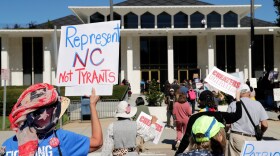A panel of trial judges made additional changes to North Carolina's congressional district map Wednesday, declaring that the latest U.S. House redistricting performed by the General Assembly fails to meet standards of partisan fairness set recently by the state Supreme Court.
The three trial judges accepted the recommendations of special masters they appointed to assist them with scrutinizing legislative and congressional boundaries that were approved last week by the Republican-controlled legislature.
Superior court judges Graham Shirley, Nathaniel Poovey and Dawn Layton did uphold the new General Assembly districts, confirming their experts' recommendation that statistics associated with the lines show them to “meet the test of presumptive constitutionality.”
But on the U.S. House map, the judges wrote, “the court concludes that the remedial congressional plan does not satisfy the Supreme Court's standards.” The judges unveiled a new congressional map they adopted.
Barring any appeal to the Supreme Court later Wednesday that results in a delay, candidate filing resumes at 8 a.m. Thursday under the new boundaries for the May 17 primary. Candidate filing was suspended in December and the primary delayed from March so lawsuits challenging maps could be tried.
The replacement congressional plan makes significant changes in the Greensboro-Winston-Salem area, which had been divided into three districts. The interim plan approved by the judges divides the region into two districts.
A 4-3 Supreme Court majority this month had overturned maps the Republican-controlled legislature enacted in November, writing that the lines prevented a large bloc of voters that supported Democrats from having a fair opportunity to increase their political influence. The justices said they were partisan gerrymanders that violated the state constitution’s free election, freedom of speech and equal protection clauses.
The justices accepted evidence from voters and advocacy groups who sued over the maps that lines were manipulated to make it almost impossible for Democrats, no matter the favorable environment, to earn majorities. In contrast, statewide elections in North Carolina are usually very close.
Lawmakers were given two weeks to draw replacement maps, and GOP leaders said the remedial boundaries increase partisan fairness and meet statistical thresholds the Supreme Court suggested could be used to ensure they were constitutionally compliant.
For each map — for the state House, state Senate and the U.S. House delegation — Republicans have a slight electoral seat advantage, according to analyses when the lines are overlapped with the results of 12 statewide elections from 2016 and 2020. But Democrats have a path to win majorities in a favorable political year.
The congressional map the judges set aside Wednesday appeared to strongly favor a Republican candidate in six districts, while four strongly favor a Democrat. The other four are considered highly competitive, with two of them likely tossups.
The political projections of the interim congressional plan was not immediately clear Wednesday.
But in a report attached to the ruling, special masters Bob Orr, Bob Edmunds and Tom Ross wrote the interim plan “achieves the partisan fairness and ‘substantially equal voting power’ required by the Supreme Court" — while meeting other principles, including protecting the rights of Black voters. Orr and Edmunds are former state Supreme Court justices, while Ross is an ex-trial judge and former University of North Carolina system president.






